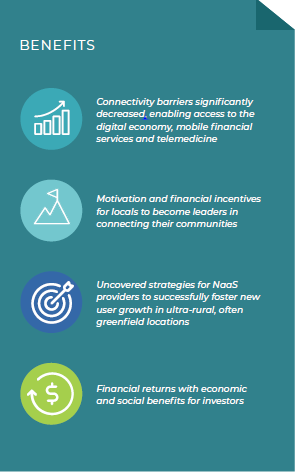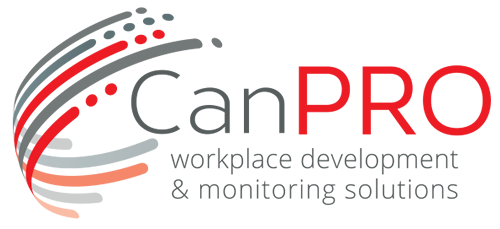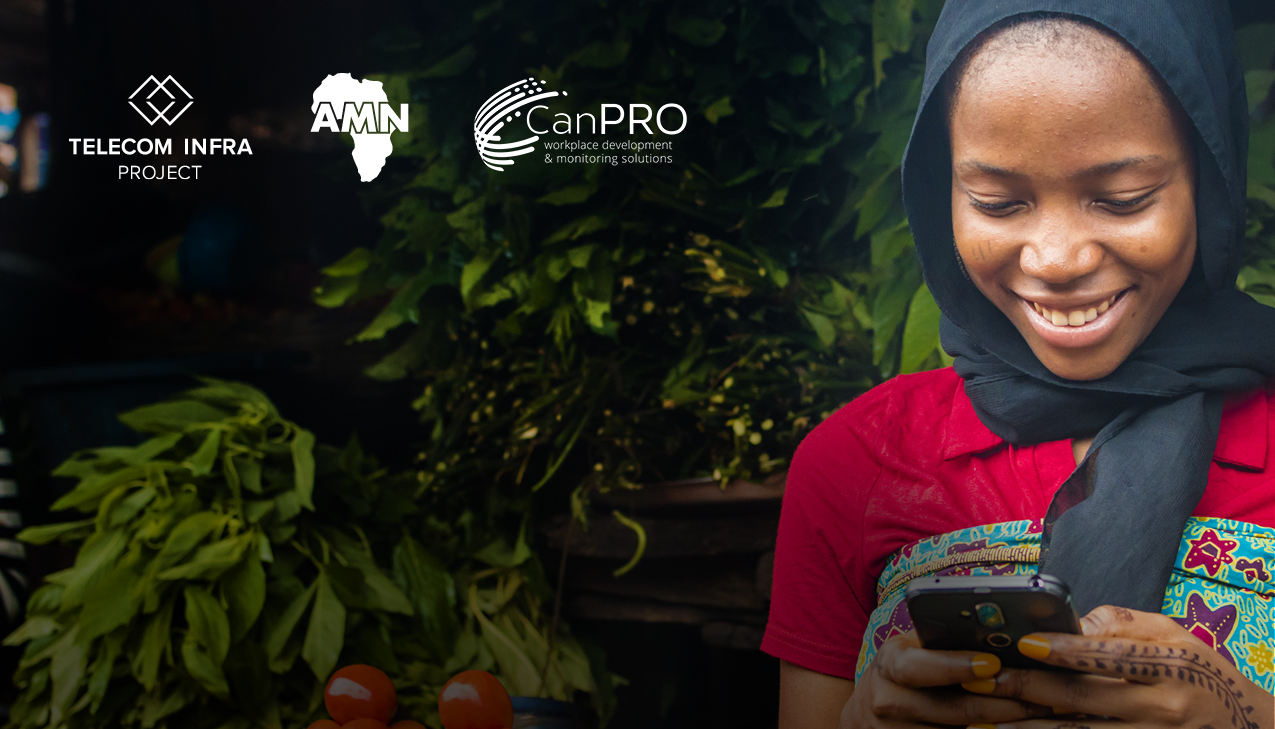Digital Ambassadors deliver hands-on training and support to their communities to help more people connect to the internet

ABOUT AFRICA MOBILE NETWORKS
Africa Mobile Networks (AMN) owns and operates network infrastructure that delivers
services for the biggest mobile operators in Africa. Also a founding member of the Telecom Infra Project (TIP), AMN is working to build infrastructure and frameworks that help rural communities gain access to the internet.
ABOUT META CONNECTIVITY
Meta Connectivity works closely with partners in the mobile ecosystem to help connect more people to a faster internet. Also part of the TIP NaaS Solution Project Group, Meta Connectivity works with partners to develop programs that promote mobile-internet adoption in newly connected communities, innovate new business models, optimize network site planning and provide network design expertise
ABOUT CANPRO
CanPro drives adoption of digital products and services by providing in-person Digital Ambassadors to establish and service SMART ecosystems, a community-driven platform, live analytics and built-in virality.
CHALLENGE
Mobile connectivity can change lives in remote parts of the world where the internet has yet to reach. People can gain access to the digital economy and participate in online education. Farmers can plan around weather forecasts and market crop prices. In a connected world, healthcare outcomes can improve with access to telemedicine and expanded care networks.
But it takes more than a network to get the internet into the hands of people living in many ultra-rural locations. Especially in areas gaining internet access for the first time, communities need an ecosystem of enabling factors to support adoption—including skills training, network access and low-cost smart devices.
AMN designed a turnkey network-as-a-service (NaaS) solution to bring 2G, 3G and 4G voice and data connectivity to remote villages in sub-Saharan Africa, connecting communities that never before had access to a mobile network. NaaS is an emerging business model that allows for open infrastructure sharing, giving mobile operators an equal access, low-cost way to extend their reach into ultra-rural areas.
After upgrading its ultra-rural NaaS network in Zambia for local operator MTN from 2G to 3G, AMN observed extremely low data usage and new user growth. It quickly became evident to AMN that there were still significant barriers to adoption, even with the expanded coverage.
Did community members lack digital skills? Were data costs too high? Were smartphones available? Did environmental or lifestyle factors negatively influence adoption or data usage?
SOLUTION
Low mobile internet adoption is often an indication that users are not aware of the technology or are not competent or confident in using it. Other factors such as cost of data, access to smartphones and proximity to infrastructure can also impact how people access the internet.
Meta Connectivity and AMN partnered with CanPro to trial their Digital Ambassadors model, which identifies, trains and supports local youth to create and maintain a SMART digital ecosystem that can drive internet adoption in newly connected communities.
A SMART digital ecosystem consists of the following interdependent elements:
- Smart device access
- Mobile broadband network coverage
- Access to the mobile broadband network
- Relevant and meaningful services and content bundling
- Training of digital skills in communities
To implement and test the effectiveness of interventions facilitated by DAs, the partners set up adoption labs in six ultra-rural Zambia villages experiencing low data usage after 3G installation. Six similar villages were also observed as a control group for the study, which took place between December 2020 and May 2021.
DIGITAL LITERACY TRAINING
In each of the six test villages, local youth were selected and trained by CanPro as DAs. Using smartphones provided to them, the DAs taught first time internet users basic skills such as device and SIM requirements, how to connect online, how to access and manage data and online safety.
In addition, DAs taught community members to leverage online services using CanPro’s maru.community application. For example, trainees were prompted to create digital profiles, upload local news and needs, advertise goods and services, and provide reviews of the digital training.
Throughout the process, CanPro remotely validated and monitored the DA’s activities and tracked program efficacy using its WorkPro application. Additionally, the application helped to track overall program effectiveness and facilitated tracking and compensation for DAs for successfully completed activities.
NETWORK MONITORING AND ACCESS
In January, the study showed continued low-data usage among trained villagers, prompting CanPro to conduct a survey via the DAs. Local feedback pointed to issues with network availability and access.
To minimize network availability challenges, AMN introduced monitoring and reporting to the program. DAs were excellently positioned to report on network availability and interruptions directly to AMN. Because DAs could identify and investigate issues fast, the program reduced network downtime, especially over weekends. This also improved the quality of the training.
The remote locations of some of the villages resulted in conditions that prohibited access to the new network. Only three of the six villages had Talk Time resellers, and only two of the villages were equipped with Mobile Money agents who could purchase additional stock online. Resellers from other villages had to travel over 100km to deposit cash at a MTN dealership to buy online stock.
In response, AMN registered DAs as Mobile Money agents who could help users convert cash into online payments and make purchases of cellular talk time and data. Text messages were sent to trained users to popularize the change. This created a viable financial opportunity for the DAs, and by March, average daily data usage per site increased from 0.9 GB to 2.1 GB.

LOW-COST SMARTPHONES
The final barrier was access to low-cost smartphones. Of the trained user group, 68% did not own a smartphone, although most reported that access to one would make it possible for them to be more active online. None of the villages in the study hosted a smartphone retailer, so even without a cost barrier, there was still no way users could purchase these devices easily.
At the beginning of the study, CanPro equipped DAs with low-cost dual SIM smartphones as training devices (also used to test user acceptance of the specific model). Once the trained users were satisfied with these devices, CanPro ordered the smartphones in bulk and offered them at a discounted price to trained villagers. This proved to be another high-impact intervention. On average, usage increased among the villages to 3 GB per
site per day.
NEXT STEPS
The absence of SMART ecosystem elements leaves aspiring users without the opportunity to access the internet and its multitude of benefits, even when they have interest and financial capability. It is key for NaaS company (NaaSCo) operators, particularly in remote rural locations, to address all five components of a healthy digital ecosystem.
Contracting DAs to create and service a SMART digital ecosystem was paramount to the success of this program. As trusted members of their communities, DAs could translate the benefits of internet adoption in ways that were directly relevant to villagers’ lifestyles. Because DAs understood local needs and pain points, they successfully built bridges between network operators and the ultra-rural communities they serve.

Each of the interventions—digital training, network monitoring and access, and low-cost smartphones—resulted in increased data usage while opening doors for new internet users. AMN will leverage these lessons to expand network adoption in rural communities, ensuring that more people receive the benefits of connectivity, no matter where they are located.
To learn more about:
• AMN, visit africanmobilenetworks.com
• Meta Connectivity, visit facebook.com/connectivity
• CanPro, visit canpro.co.za
For resources and information about how to support adoption for ultra-rural, rural and first-time internet users, visit telecominfraproject.com/naas/


